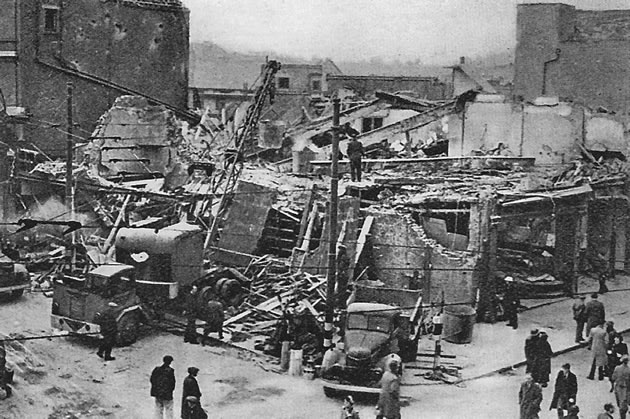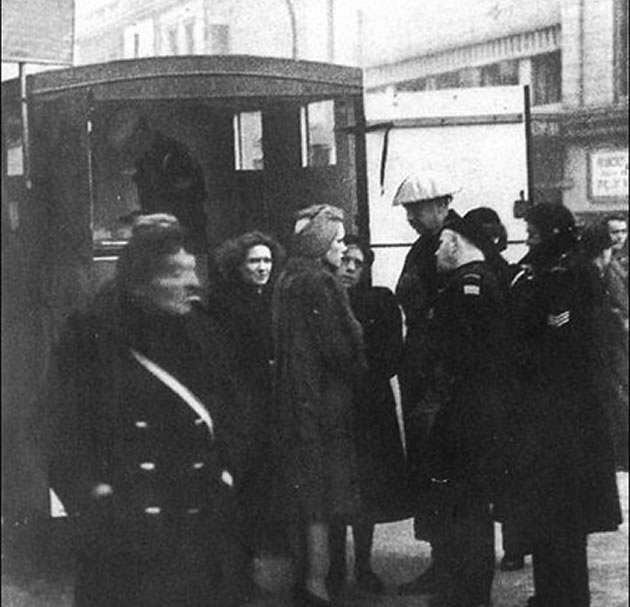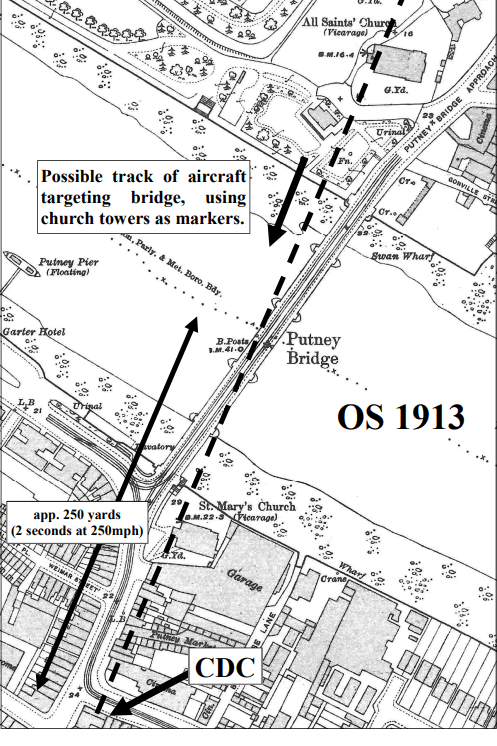Call for plaque to be placed at site of the Cinderella Dancing Club bombing

Cinderella Dancing Club/Black & White Milk Bar, Putney High Street, 7th November 1943
|
A campaign has been launched to have a plaqueplaced at the site of the wartime bombing in Putney which resulted in the deaths of 81 people.
On the evening of 7 November 1943, crowds were packed into the Cinderella Dancing Club on the corner of Putney High Street and Putney Bridge Road. The area’s three local cinemas had just finished their films so the centre of town was busier than usual.
A German bomber, likely to be aiming to blow up Putney Bridge dropped a single device which hit the club at 9.02pm, leading to the area’s worst death toll during the war. 46 females and 35 males died of which 18 were service personnel and 248 were also injured. The Black and White Milk Bar, which was on the floor below the dance hall was also devastated. The youngest victim was 14-year-old Edward Smith.
Air raid warden Don Williams had just visited the Black and White Milk Bar with three friends after seeing what he described as a second-rate American gangster film at the cinema.
They were members of the Cinderella Dance Club but decided not to go in that night after hearing the band. After getting some soup they wandered up the High Street and were halfway across Lacy Road when they heard the sound of a diving bomber.

Civil defence workers in Putney after the attack
Mr Williams said, “This was unusual, as bombers over London did not normally dive; (it may have been attempting to hit Putney Bridge). The crowd scattered, some six people ran into the doorway of the Maypole Dairy, myself being the last one in. The explosion far exceeded what could be called ‘sound’ and we were all blown some thirty feet into the back room of the shop. Being the last one in, I received the greatest injury of the little group. There was a lot of blood running down from my head and face.”
After a short silence, there was the sound of crying and screaming and, despite of his injuries, Mr Williams made towards the point of impact of the bomb.
He says, “The corner of Putney High Street and Putney Bridge Road included Rego Clothiers, Meaker’s outfitters, the Milk Bar, a tobacconist’s, part of Cullen’s the grocers, as well as the premises above them, and the entire area was now a pile of rubble which had spilled over two-thirds of the road. Nothing remained of the dance hall except a few beams at floor level. On the other side of the road the buildings were all gutted and a fire had started in the basement of John Perring’s furniture store.”
He could only find two people alive one on his back on the manhole cover outside the Bull & Star public house, directly opposite the explosion. The other was the elderly lady who just a few minutes earlier had served them their soup.
He started to help clear rubble to look for survivors but the fire gained in intensity. He decided to return to his home in Hotham Road and get his civil defence overalls and helmet, and was back on site in a few minutes.
When he returned the man and the old lady were no longer there but civil defence workers had already started to stack up bodies on the pavement outside the confectioner’s shop.
Despite working through the night and the following day he did not see any other survivors pulled out of the rubble. Once they gained access to the dance hall it was a matter of removing bodies and body parts and he describes finding a young woman’s hand, severed above the wrist, in a high quality soft blue leather glove.
Only after he had been working at the site for some time did he receive treatment for the large pieces of glass embedded in his leg at the time of the original blast. He later made a claim for what would now be described as post-traumatic stress due to his experiences but this was rejected.

A tomb of one of the victims of the attack
Local expert Jon Temple has looked at the incident and concluded that the bomb was dropped by a Focke-Wulf FW-190 A-4. It was one of only around six planes that entered UK air space that night, the Blitz having passed its most intense phase. The plane is thought to have flown to an air field north of Paris and was one of the last of its unit remaining with the rest having already been deployed to Italy. It would have taken a fast low approach to its target and deployed a single large bomb which is believed to have weighed 250kg.
These planes were designed to fly low over specific targets such as bridges and railways with spiked bombs intended to prevent deflection. It is believed that the aircraft was using two Church steeples including St Mary’s Putney to target the bomb on Putney Bridge. Mr Temple believes the bomb was released late by about two seconds and that resulted in it hitting the dance hall and not the bridge. There were two FW-190s that flew in the attack that night and both were lost, one shot down by a Mosquito night-fighter with the others fate unknown. Mr Temple has been unable to learn the names of the pilots.

Picture: Jon Temple
Thamesfield councillor Mike Ryder now wants this event to be officially commemorated. He was asked about the possibility of a memorial plaque by a local resident, in light of proposals to redevelop that corner of the High Street to erect a hotel and shops and offices.
Councillor Ryder, who is being supported by fellow councillors John Locker and Rosemary Torrington, was given the full story of the tragedy by local historian Philip Evison and has now contacted Wandsworth Council’s Heritage Service to appeal for a plaque.
He said, “It would be good to get a plaque in place now, so it will be there when the site is redeveloped. We all care about our futures, but we need to understand and honour our past too.”
He added: “I know the Putney Society is also very keen to have a plaque marking this sad moment in the town’s wartime history.”
Councillor Ryder has been told that the borough Heritage Service has strong support for the idea of the plaque, but he added, ”Apparently there is a feeling that if a plaque is approved it should wait until the site is redeveloped. But i think we should put one up now on one of the existing buildings, and then move it to a permanent spot when the site is developed. If we keep waiting it may never happen.”
The Putney Society have suggested the council making the plaque a condition of future planning approval for redevelopment of the site.
October 9, 2020